2007 FIAT SEDICI warning
[x] Cancel search: warningPage 167 of 266
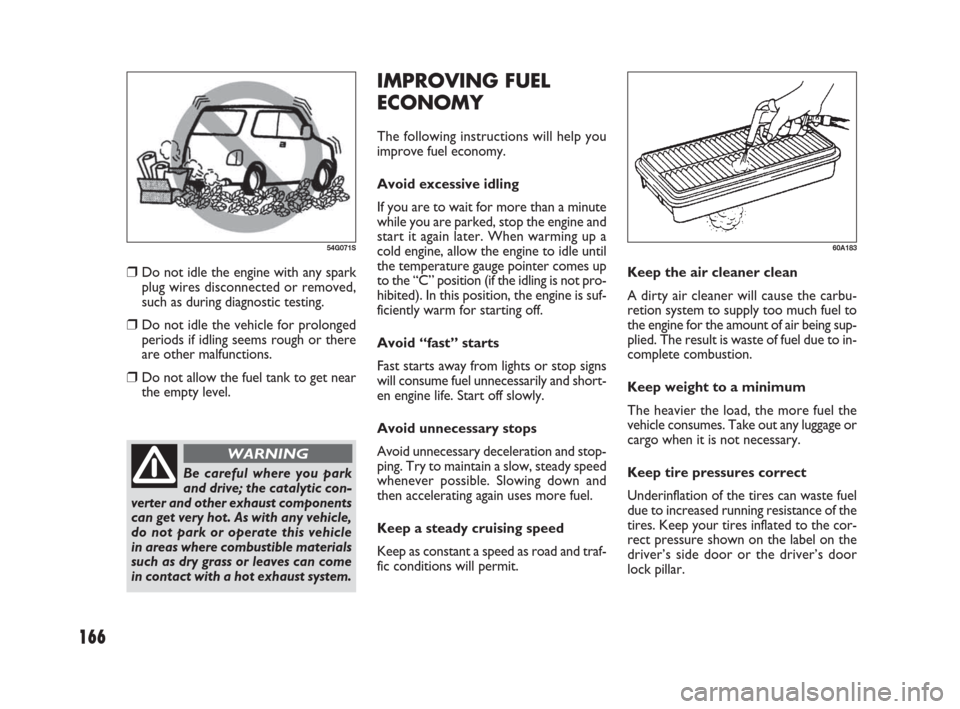
166
IMPROVING FUEL
ECONOMY
The following instructions will help you
improve fuel economy.
Avoid excessive idling
If you are to wait for more than a minute
while you are parked, stop the engine and
start it again later. When warming up a
cold engine, allow the engine to idle until
the temperature gauge pointer comes up
to the “C” position (if the idling is not pro-
hibited). In this position, the engine is suf-
ficiently warm for starting off.
Avoid “fast” starts
Fast starts away from lights or stop signs
will consume fuel unnecessarily and short-
en engine life. Start off slowly.
Avoid unnecessary stops
Avoid unnecessary deceleration and stop-
ping. Try to maintain a slow, steady speed
whenever possible. Slowing down and
then accelerating again uses more fuel.
Keep a steady cruising speed
Keep as constant a speed as road and traf-
fic conditions will permit.Keep the air cleaner clean
A dirty air cleaner will cause the carbu-
retion system to supply too much fuel to
the engine for the amount of air being sup-
plied. The result is waste of fuel due to in-
complete combustion.
Keep weight to a minimum
The heavier the load, the more fuel the
vehicle consumes. Take out any luggage or
cargo when it is not necessary.
Keep tire pressures correct
Underinflation of the tires can waste fuel
due to increased running resistance of the
tires. Keep your tires inflated to the cor-
rect pressure shown on the label on the
driver’s side door or the driver’s door
lock pillar.
60A183
❒Do not idle the engine with any spark
plug wires disconnected or removed,
such as during diagnostic testing.
❒Do not idle the vehicle for prolonged
periods if idling seems rough or there
are other malfunctions.
❒Do not allow the fuel tank to get near
the empty level.
54G071S
Be careful where you park
and drive; the catalytic con-
verter and other exhaust components
can get very hot. As with any vehicle,
do not park or operate this vehicle
in areas where combustible materials
such as dry grass or leaves can come
in contact with a hot exhaust system.
WARNING
149-166 Fiat16 New GB 27-11-2007 11:27 Pagina 166
Page 169 of 266
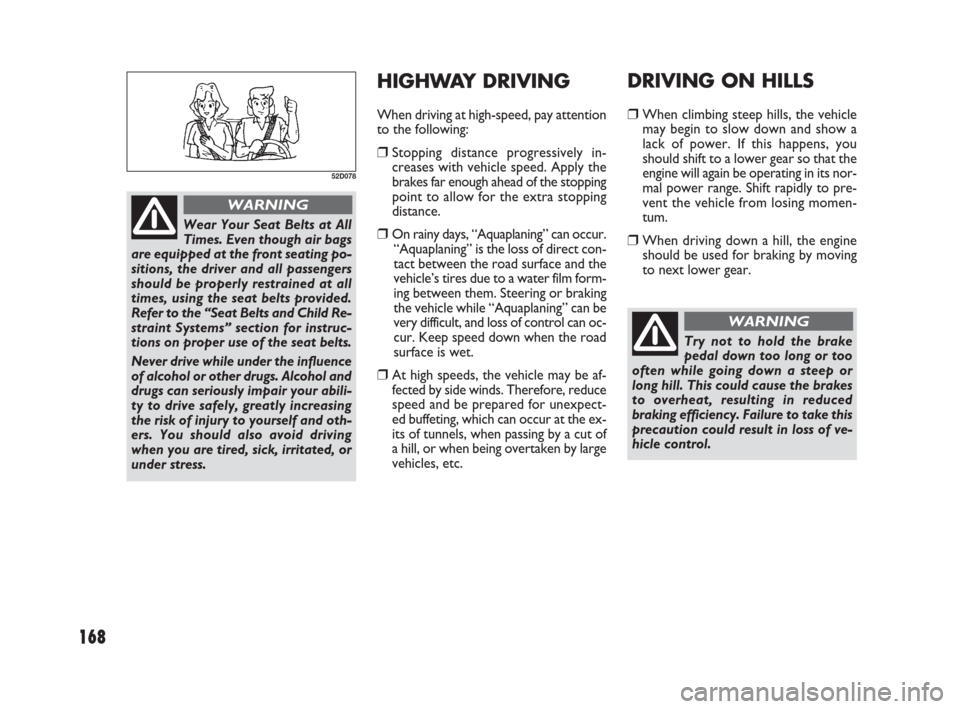
168
HIGHWAY DRIVING
When driving at high-speed, pay attention
to the following:
❒Stopping distance progressively in-
creases with vehicle speed. Apply the
brakes far enough ahead of the stopping
point to allow for the extra stopping
distance.
❒On rainy days, “Aquaplaning” can occur.
“Aquaplaning” is the loss of direct con-
tact between the road surface and the
vehicle’s tires due to a water film form-
ing between them. Steering or braking
the vehicle while “Aquaplaning” can be
very difficult, and loss of control can oc-
cur. Keep speed down when the road
surface is wet.
❒At high speeds, the vehicle may be af-
fected by side winds. Therefore, reduce
speed and be prepared for unexpect-
ed buffeting, which can occur at the ex-
its of tunnels, when passing by a cut of
a hill, or when being overtaken by large
vehicles, etc.
DRIVING ON HILLS
❒When climbing steep hills, the vehicle
may begin to slow down and show a
lack of power. If this happens, you
should shift to a lower gear so that the
engine will again be operating in its nor-
mal power range. Shift rapidly to pre-
vent the vehicle from losing momen-
tum.
❒When driving down a hill, the engine
should be used for braking by moving
to next lower gear.
52D078
Wear Your Seat Belts at All
Times. Even though air bags
are equipped at the front seating po-
sitions, the driver and all passengers
should be properly restrained at all
times, using the seat belts provided.
Refer to the “Seat Belts and Child Re-
straint Systems” section for instruc-
tions on proper use of the seat belts.
Never drive while under the influence
of alcohol or other drugs. Alcohol and
drugs can seriously impair your abili-
ty to drive safely, greatly increasing
the risk of injury to yourself and oth-
ers. You should also avoid driving
when you are tired, sick, irritated, or
under stress.
WARNING
Try not to hold the brake
pedal down too long or too
often while going down a steep or
long hill. This could cause the brakes
to overheat, resulting in reduced
braking efficiency. Failure to take this
precaution could result in loss of ve-
hicle control.
WARNING
167-170 Fiat16 New GB 27-11-2007 11:28 Pagina 168
Page 171 of 266

170
IMPORTANT Do not continue rocking
the vehicle for more than a few minutes.
Prolonged rocking can cause engine over-
heating or transaxle damage. IF YOUR VEHICLE GETS STUCK
If your vehicle gets stuck in snow, mud, or
sand, follow the directions below:
❒Shift the transaxle back and forth be-
tween first gear and reverse. This will
create a rocking motion which may give
you enough momentum to free the ve-
hicle. Press gently on the accelerator to
keep wheel spin to a minimum.
Remove your foot from the accelera-
tor while shifting.
Do not race the engine. Excessive
wheel spin will cause the tires to dig
deeper, making it more difficult to free
the vehicle.
❒If your vehicle remains stuck after a few
minutes of rocking, get another vehicle
to pull you out.
Do not allow anyone to
stand near the vehicle when
you are rocking it, and do not spin the
wheels faster than an indicated
40 km/h (25 mph) on the speedome-
ter. Personal injury and/ or vehicle
damage may result from spinning the
wheels too fast.
WARNING
54G074S
In addition to following the
driving tips in this section, it
is important to observe the following
precautions.
Make sure your tires are in good con-
dition and always maintain the spec-
ified tire pressure. Refer to “Tires” in
the “INSPECTION AND MAINTE-
NANCE” section for details.
WARNING
Do not use tires other than
those specified by Fiat. Nev-
er use different sizes or types of tires
on the front and rear wheels. For in-
formation regarding the specified
tires, refer to the Tire Information La-
bel located on the driver’s door lock
pillar.
Never use oversized tires or special
shock absorbers and springs to raise
(jack up) your vehicle. This will
change the handling characteristics.
Oversized tires may also rub against
the fender over bumps, causing vehi-
cle damage or tire failure.
After driving through water, test the
brakes while driving at a slow speed
to see if they have maintained their
normal effectiveness. If the brakes are
less effective than normal, dry them
by repeatedly applying the brakes
while driving slowly until the brakes
have regained their normal effective-
ness.
WARNING
167-170 Fiat16 New GB 27-11-2007 11:28 Pagina 170
Page 173 of 266
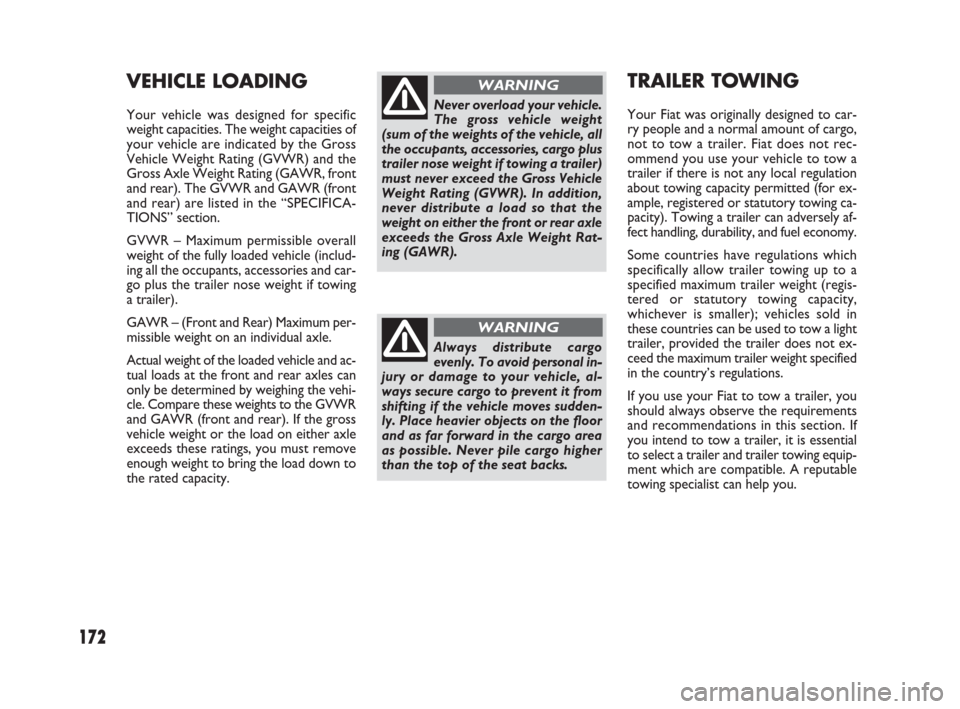
172
TRAILER TOWING
Your Fiat was originally designed to car-
ry people and a normal amount of cargo,
not to tow a trailer. Fiat does not rec-
ommend you use your vehicle to tow a
trailer if there is not any local regulation
about towing capacity permitted (for ex-
ample, registered or statutory towing ca-
pacity). Towing a trailer can adversely af-
fect handling, durability, and fuel economy.
Some countries have regulations which
specifically allow trailer towing up to a
specified maximum trailer weight (regis-
tered or statutory towing capacity,
whichever is smaller); vehicles sold in
these countries can be used to tow a light
trailer, provided the trailer does not ex-
ceed the maximum trailer weight specified
in the country’s regulations.
If you use your Fiat to tow a trailer, you
should always observe the requirements
and recommendations in this section. If
you intend to tow a trailer, it is essential
to select a trailer and trailer towing equip-
ment which are compatible. A reputable
towing specialist can help you.
VEHICLE LOADING
Your vehicle was designed for specific
weight capacities. The weight capacities of
your vehicle are indicated by the Gross
Vehicle Weight Rating (GVWR) and the
Gross Axle Weight Rating (GAWR, front
and rear). The GVWR and GAWR (front
and rear) are listed in the “SPECIFICA-
TIONS” section.
GVWR – Maximum permissible overall
weight of the fully loaded vehicle (includ-
ing all the occupants, accessories and car-
go plus the trailer nose weight if towing
a trailer).
GAWR – (Front and Rear) Maximum per-
missible weight on an individual axle.
Actual weight of the loaded vehicle and ac-
tual loads at the front and rear axles can
only be determined by weighing the vehi-
cle. Compare these weights to the GVWR
and GAWR (front and rear). If the gross
vehicle weight or the load on either axle
exceeds these ratings, you must remove
enough weight to bring the load down to
the rated capacity.Never overload your vehicle.
The gross vehicle weight
(sum of the weights of the vehicle, all
the occupants, accessories, cargo plus
trailer nose weight if towing a trailer)
must never exceed the Gross Vehicle
Weight Rating (GVWR). In addition,
never distribute a load so that the
weight on either the front or rear axle
exceeds the Gross Axle Weight Rat-
ing (GAWR).
WARNING
Always distribute cargo
evenly. To avoid personal in-
jury or damage to your vehicle, al-
ways secure cargo to prevent it from
shifting if the vehicle moves sudden-
ly. Place heavier objects on the floor
and as far forward in the cargo area
as possible. Never pile cargo higher
than the top of the seat backs.
WARNING
171-180 Fiat16 New GB 27-11-2007 11:29 Pagina 172
Page 174 of 266
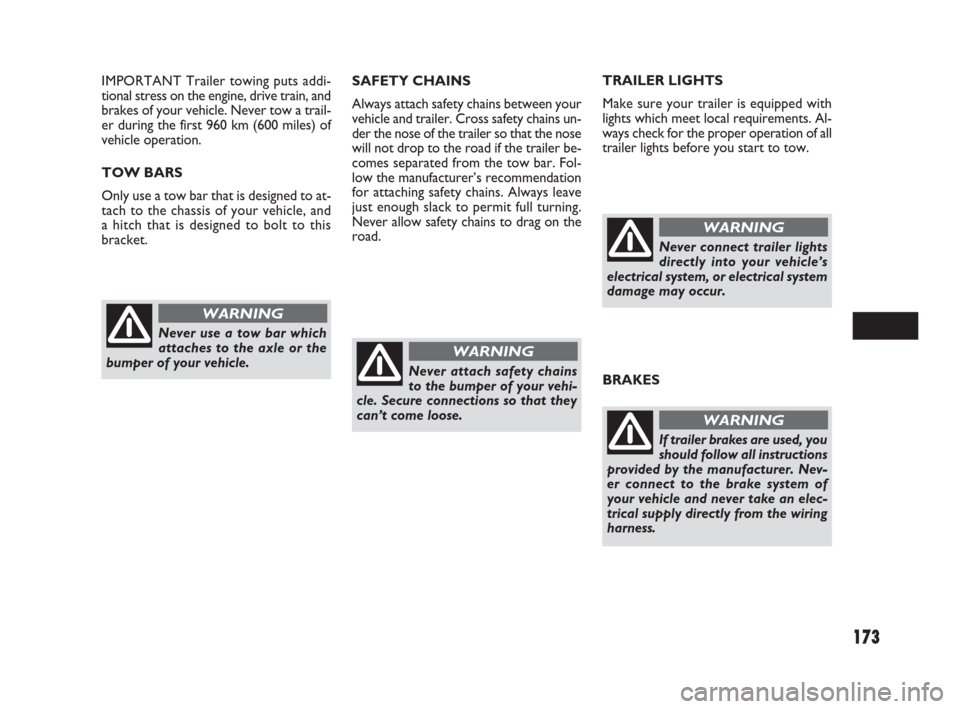
Never use a tow bar which
attaches to the axle or the
bumper of your vehicle.
WARNING
Never attach safety chains
to the bumper of your vehi-
cle. Secure connections so that they
can’t come loose.
WARNING
Never connect trailer lights
directly into your vehicle’s
electrical system, or electrical system
damage may occur.
WARNING
BRAKES
If trailer brakes are used, you
should follow all instructions
provided by the manufacturer. Nev-
er connect to the brake system of
your vehicle and never take an elec-
trical supply directly from the wiring
harness.
WARNING
173
SAFETY CHAINS
Always attach safety chains between your
vehicle and trailer. Cross safety chains un-
der the nose of the trailer so that the nose
will not drop to the road if the trailer be-
comes separated from the tow bar. Fol-
low the manufacturer’s recommendation
for attaching safety chains. Always leave
just enough slack to permit full turning.
Never allow safety chains to drag on the
road.TRAILER LIGHTS
Make sure your trailer is equipped with
lights which meet local requirements. Al-
ways check for the proper operation of all
trailer lights before you start to tow. IMPORTANT Trailer towing puts addi-
tional stress on the engine, drive train, and
brakes of your vehicle. Never tow a trail-
er during the first 960 km (600 miles) of
vehicle operation.
TOW BARS
Only use a tow bar that is designed to at-
tach to the chassis of your vehicle, and
a hitch that is designed to bolt to this
bracket.
171-180 Fiat16 New GB 27-11-2007 11:29 Pagina 173
Page 175 of 266

174
MIRRORS
Check to see if your vehicle’s mirrors
meet local requirements for mirrors used
on towing vehicles. If they do not, you
must install the required mirrors before
you tow.
VEHICLE/TRAILER LOADING
To load your vehicle and trailer proper-
ly, you must know how to measure gross
trailer weight and trailer nose weight.
Gross Trailer Weight is the weight of the
trailer plus all the cargo in it. You can mea-
sure gross trailer weight by putting the ful-
ly loaded trailer on a vehicle scale.
Nose Weight is the downward force ex-
erted on the tow bar by the trailer cou-
pler, with the trailer fully loaded and the
coupler at its normal towing height. This
weight can be measured using a bathroom
scales.
The weight of your loaded trailer (Gross
Trailer Weight) should never exceed the
“Towing capacity”.Distribute cargo in your trailer so that
nose weight is about 10% of gross trailer
weight, but does not exceed “Maximum
vertical load on trailer hitch point”. You
should measure gross trailer weight and
nose weight before towing to make sure
that your load is properly distributed. TIRES
When towing a trailer, it is
very important for your ve-
hicle and trailer to have properly in-
flated tires. Your vehicle’s tires should
be inflated to the pressures listed on
your vehicles Tire Information label.
If laden pressures are listed on the la-
bel, the tires should be inflated to the
laden pressures. Inflate trailer tires
according to the specifications pro-
vided by the trailer manufacturer.
WARNING
Improper weight distribution
of your trailer may result in
poor vehicle handling and swaying of
the trailer. Always make sure that
trailer nose weight is about 10% of
gross trailer weight, but does not ex-
ceed “Maximum vertical load on
trailer hitch point”. Also make sure
that the cargo is properly secured.
Failure to observe this requirement
may result in an accident.
WARNING
171-180 Fiat16 New GB 27-11-2007 11:29 Pagina 174
Page 176 of 266
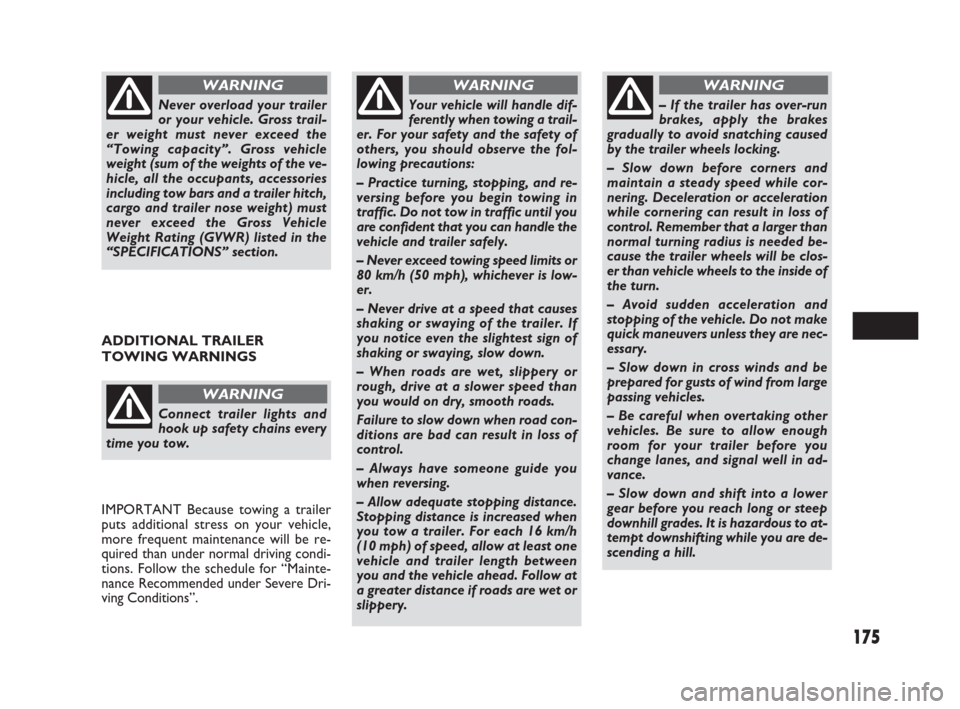
175
ADDITIONAL TRAILER
TOWING WARNINGS
Never overload your trailer
or your vehicle. Gross trail-
er weight must never exceed the
“Towing capacity”. Gross vehicle
weight (sum of the weights of the ve-
hicle, all the occupants, accessories
including tow bars and a trailer hitch,
cargo and trailer nose weight) must
never exceed the Gross Vehicle
Weight Rating (GVWR) listed in the
“SPECIFICATIONS” section.
WARNING
Connect trailer lights and
hook up safety chains every
time you tow.
WARNING
IMPORTANT Because towing a trailer
puts additional stress on your vehicle,
more frequent maintenance will be re-
quired than under normal driving condi-
tions. Follow the schedule for “Mainte-
nance Recommended under Severe Dri-
ving Conditions”.
Your vehicle will handle dif-
ferently when towing a trail-
er. For your safety and the safety of
others, you should observe the fol-
lowing precautions:
– Practice turning, stopping, and re-
versing before you begin towing in
traffic. Do not tow in traffic until you
are confident that you can handle the
vehicle and trailer safely.
– Never exceed towing speed limits or
80 km/h (50 mph), whichever is low-
er.
– Never drive at a speed that causes
shaking or swaying of the trailer. If
you notice even the slightest sign of
shaking or swaying, slow down.
– When roads are wet, slippery or
rough, drive at a slower speed than
you would on dry, smooth roads.
Failure to slow down when road con-
ditions are bad can result in loss of
control.
– Always have someone guide you
when reversing.
– Allow adequate stopping distance.
Stopping distance is increased when
you tow a trailer. For each 16 km/h
(10 mph) of speed, allow at least one
vehicle and trailer length between
you and the vehicle ahead. Follow at
a greater distance if roads are wet or
slippery.
WARNING
– If the trailer has over-run
brakes, apply the brakes
gradually to avoid snatching caused
by the trailer wheels locking.
– Slow down before corners and
maintain a steady speed while cor-
nering. Deceleration or acceleration
while cornering can result in loss of
control. Remember that a larger than
normal turning radius is needed be-
cause the trailer wheels will be clos-
er than vehicle wheels to the inside of
the turn.
– Avoid sudden acceleration and
stopping of the vehicle. Do not make
quick maneuvers unless they are nec-
essary.
– Slow down in cross winds and be
prepared for gusts of wind from large
passing vehicles.
– Be careful when overtaking other
vehicles. Be sure to allow enough
room for your trailer before you
change lanes, and signal well in ad-
vance.
– Slow down and shift into a lower
gear before you reach long or steep
downhill grades. It is hazardous to at-
tempt downshifting while you are de-
scending a hill.
WARNING
171-180 Fiat16 New GB 27-11-2007 11:29 Pagina 175
Page 177 of 266
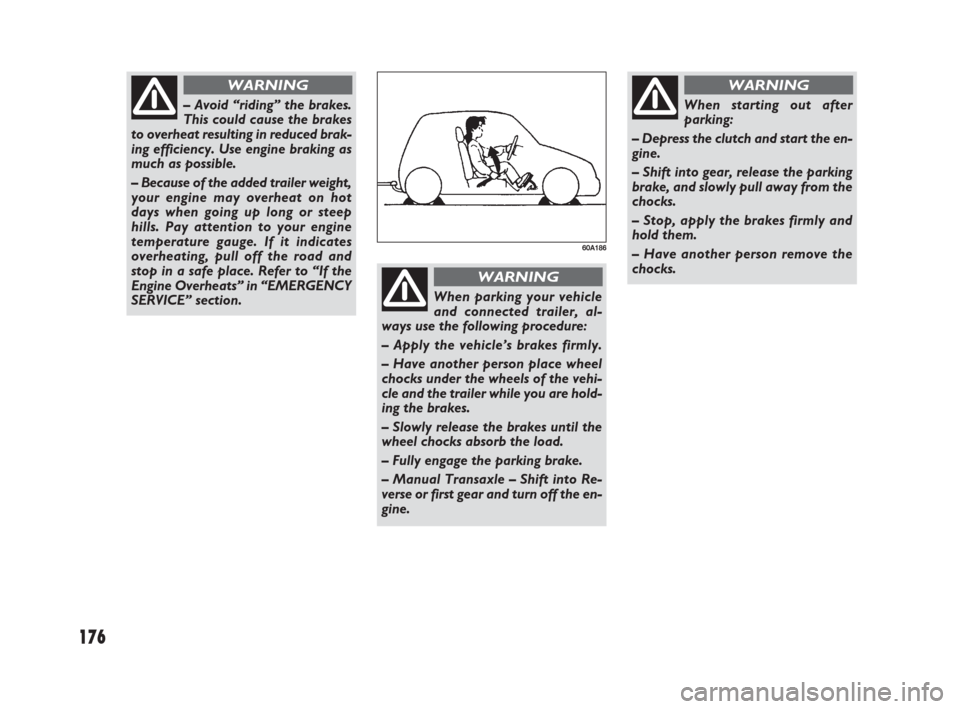
176
– Avoid “riding” the brakes.
This could cause the brakes
to overheat resulting in reduced brak-
ing efficiency. Use engine braking as
much as possible.
– Because of the added trailer weight,
your engine may overheat on hot
days when going up long or steep
hills. Pay attention to your engine
temperature gauge. If it indicates
overheating, pull off the road and
stop in a safe place. Refer to “If the
Engine Overheats” in “EMERGENCY
SERVICE” section.
WARNING
60A186
When parking your vehicle
and connected trailer, al-
ways use the following procedure:
– Apply the vehicle’s brakes firmly.
– Have another person place wheel
chocks under the wheels of the vehi-
cle and the trailer while you are hold-
ing the brakes.
– Slowly release the brakes until the
wheel chocks absorb the load.
– Fully engage the parking brake.
– Manual Transaxle – Shift into Re-
verse or first gear and turn off the en-
gine.
WARNING
When starting out after
parking:
– Depress the clutch and start the en-
gine.
– Shift into gear, release the parking
brake, and slowly pull away from the
chocks.
– Stop, apply the brakes firmly and
hold them.
– Have another person remove the
chocks.
WARNING
171-180 Fiat16 New GB 27-11-2007 11:29 Pagina 176